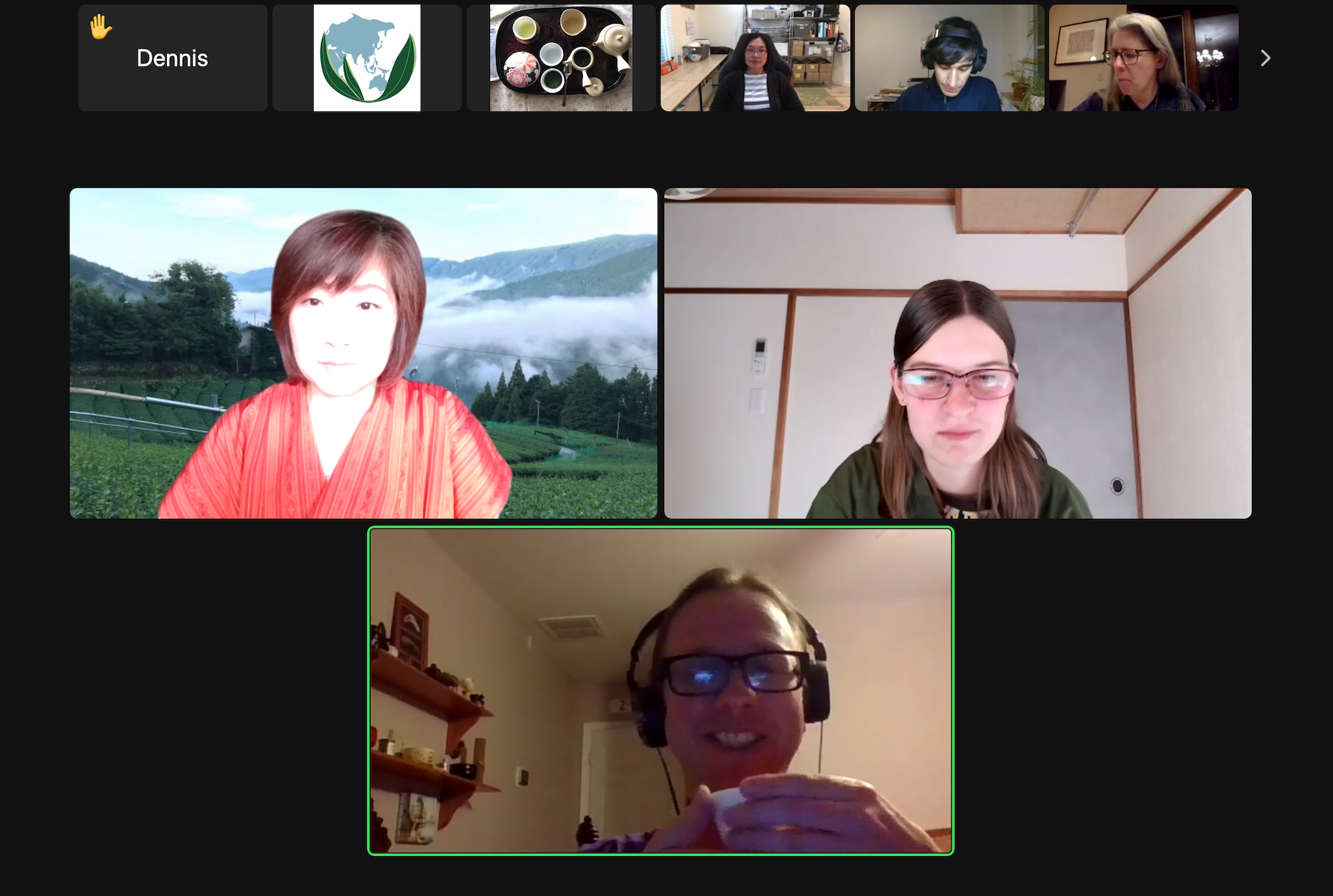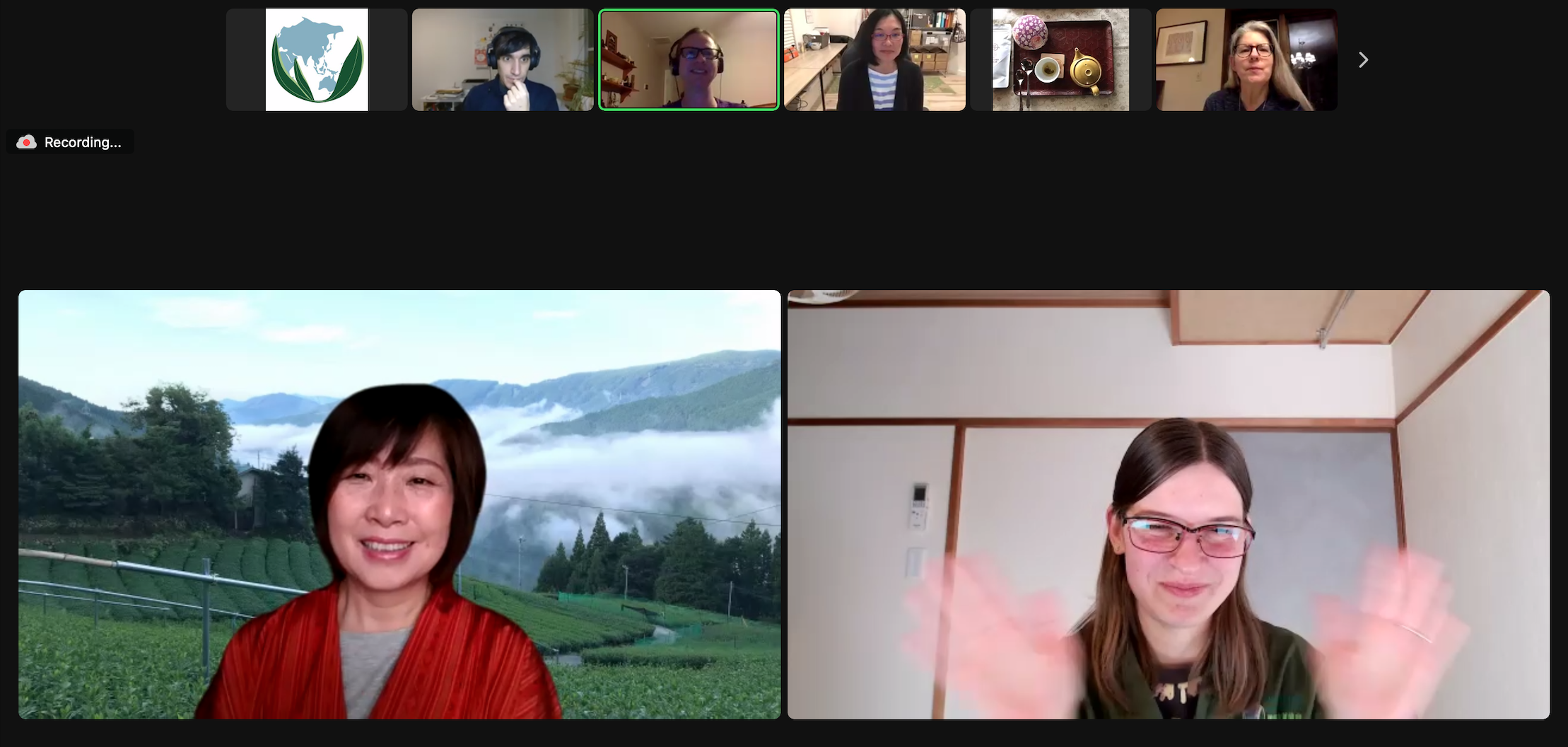On the 29th of March, we had the last Meet the Tea Farmer event before the spring tea season. This time it was Yuko Tsuchiya’s turn in joining us! She is the 3rd generation tea farmer and leader of Tsuchiya Nouen, a small family farm in Shizuoka prefecture. The town where they are based is called Kawanehoncho and it is a mountainous area around 600m above sea level. Another peculiarity of their tea farm is that they still use small machines to process the tea – in this way, they can process different batches according to customers preferences. Tsuchiya Nouen has some hand-picked teas too.
The first tea we tasted was a hand-picked sencha called Hikari Komachi. It is made using Okuhikari cultivar, which is known as a bit later shooting cultivar than Yabukita. This tea was harvested last year around the 15th of May. Yuko-san told us that typically for one person we would use 3 grams of tea and make it in a small tea pot. If you don’t have one, you can also make this tea directly in a cup. She suggested to cool down the water to 50ºC. Starting from boiling water, first pour it in the cup to measure. Then observe the steam: if it goes right up, the temperature is still quite high; once the steam starts to move sideways, the water would be at around 80°C. She then poured the water into a yuzamashi (water cooler) to cool the water further down. Finally we can pour the water in the teapot and steep for around 2 minutes. Yuko-san had a very interesting comment on the water and steeping time: in Japan the water is soft and very nice, so 1 minute and a half is enough. But if you have harder water, then she thinks steeping a bit longer works better. Another suggestion is to brew the tea at room temperature and for a longer time – it would make it lighter, if this still feels too astringent. Yuko-san was curious to know the opinion of the participants on this tea. She explained that this is the tea they can produce in the mountains of Shizuoka: the liquid pale and lemony yellow, very light in colour, but packed in flavour. This is a tea that can be brewed and enjoyed a few times.

The participants enjoyed the tea very much and a few interesting questions and discussions emerged. One was about the quantity of water to be used. Yuko-san told us a trick to calculate the amount, according to the tea one wants to drink. If we want a very condensed tea and full of flavour, the quantity of water should be around 10 times the tea leaves’ weight (30 ml for 3 grams of tea). If we want a “normal” tea, then around 20 times (60ml). If we want a very light tea, then multiply by 60!
The other question was what to do if we don’t have a kyusu. Her recommendation is to use 2 cups and do what in Japanese is called “sususricha”: sipping out of a cup. It would be similar to the Chinese style of drinking straight out of a gaiwan. But if you are bothered by the leaves, then you can use two cups: brew the tea in one and then serve it into the other.
For the second brew of this sencha, the suggestion was to pour the water into the yuzamashi and then directly into the cup, aiming at 70ºC and leaving it steep for 20 seconds. It came out richer in colour. And Yuko-san reminded us to look at the brewed leaves now: the color is really beautiful, she said, almost the same as what the leaves have in the fields just before the spring harvest. This brew is more typical of sencha: a bit less umami and more astringent. Patrick, one of the participants, added that he enjoys when a tea is brewed in different ways, so he can taste different flavours with the same tea. We do enjoy it too!

We then had an introduction about Shizuoka tea region and Tsuchiya Nouen. Yuko-san is the leader of the tea farm now, but she gets help from her husband during harvest season. Moreover her father, even if he is already 83, keeps on working regularly at the tea factory! Yuko-san is also very committed in preserving hand picking traditions. She says that picking tea by hand, you can really select what you are picking – therefore, you can really get a high quality tea in spring season. Moreover, the tea pickers are veterans and very experienced, so they can be fast but very gentle and precise at the same time. Yuko-san thinks this is a skill that deserves to be preserved. And when the tea picking ladies gather in town for harvest, it is always a beautiful and cheerful moment. Unfortunately most of the tea pickers are already around 80 years old and young people are not following the tradition. But she thinks that maybe a solution could be something like the tea hand-rolling associations. Maybe something similar could be done for hand-picking as well.

The second tea of the day was hojicha. Yuko-san suggested to use water between 80º – 90ºC, saying that hojicha is really easy to brew. The quantity was again 3 grams of tea for one person, using one cup of water and steeping for around 40 seconds.”Brewing with hotter water, we can feel the aroma better. Maybe this kind of aroma gives the same sensation to all of us around the world.”, Yuko-san said.

This hojicha is very nice, and someone even pointed out that it is very creamy! The big difference is this specific tea is the level of roasting and the leaves used. This is a lighter roast and the material for this hojicha is sencha leaves from the late spring harvest. At Tsuchiya Nouen, they want to keep the features of the sencha, that’s why this is roasted only lightly.
We had a question on the levels of caffeine in hojicha and Yuko-san pointed out that depends on the material we use for the tea rather than the roasting itself. This tea’s caffeine content is not so high as the first sencha we tasted. Often hojicha teas are recommended as an evening drink for the lower caffeine amount; Yuko-san however mentioned that tea has a diuretic effect, so maybe it is not so good to drink it very late in the evening.
In the end, we even talked about the lack of young people in the tea sector and if there could be a chance for a change involving people from abroad. Yuko-san said that tea getting popular abroad is of course very good. However, it is still a little hard for small tea farms, because they might be not be used to it and not able to handle it. In the old days, tea was the only choice in Japan. Nowadays young people have lots of choices aside from tea. So one has to actively choose tea among them.
Thank you so much, Yuko-san, for all your insights and interesting points of view! And, of course, for the lovely teas. We always feel very lucky to be able to taste such high quality teas made by very passionate and inspiring tea farmers!


